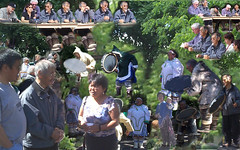I have been fascinated with rhythm for as long as I can remember. Recently, I saw an old family movie taken when I was two years old, tapping my spoon on the table between bites of Cheerios. It wasn’t until I attended my first drum circle years later (and after numerous frustrated school teachers), that I finally found a home for my incessant banging.
A unique and unexplainable sense of calm and entrancement could come over you at the peak of the communal rhythm. You don’t have to talk to the stranger sitting next to you to get to know them; everyone in the circle is interacting with rhythm. At that moment, everyone is at total peace with each other.
“The drum circle, back home, represents unity,” says Biboti Ouikahilo in a deep voice inflected with his native French. “If you participate in the circle, you create peace. Back home, it is surprisingly effective.”
“Back home” for Ouikahilo is Ivory Coast, a West African nation with rich rhythmic and dance traditions, which was colonized by France until 1960. While the colonizers may have mostly stripped Ivory Coast’s 60 ethnic groups of their native languages, their music traditions have been preserved. From his 17-year stint as a professional musician and choreographer in Ivory Coast’s National Ballet touring dance and drumming group, which showcased each of the country’s ethnic groups, Ouikahilo became an expert in the musical traditions from his homeland.
After the National Ballet dissolved in 1995, Ouikahilo made plans to share his extensive knowledge with the world. “I wanted to share what I learned in the National Ballet with people who may not know about it [these traditions], instead of staying at home,” he says. He relocated to New York City in 1997, working as a teacher and performer, and even went on tour with Jimmy Buffet in 2000. But, in 2003, while working for Syracuse University, he found his future home.
“I grew up in a big city, and when I came to the US, I lived in another big city,” Ouikahilo explains. “I didn’t think that, being in New York City, the people were going to take to my content because there are a lot of drummers and dancers there. I was trying to find a quiet region, where people would listen.”
Last year, Ouikahilo and his spouse, Jill, a Syracuse-native and African drum and dance expert, opened up their dream company, Wacheva Cultural Arts business. And they couldn’t have selected a better spot: Syracuse’s Westcott neighborhood, where artists, students, and for lack of a better word, “hippies” congregate to form a wonderfully colorful and diverse section of town. If Ouikahilo was looking for a region with open ears, he definitely found it in the Westcott Nation.
One evening after work, I grabbed a digital recorder and my trusty djembe and made the walk to participate in one of Ouikahilo’s classes.
As it turned out, I didn’t have to bring a drum at all–Ouikahilo had an impressive collection of djembes, dun duns, and shakeres, set up and ready to go in one of Wacheva’s two dance studios.
Joining three of his regular pupils and Jill, we played a traditional rhythm called kadama, which originates from Ouikahilo’s own ethnic group, the Guro people. “Kadama means ‘let’s try it’,” explains Ouikahilo.
According to legend, the rhythm known as kadama was created by the Guro people who were attempting to compose a ceremonial rhythm, but no one was willing to take the lead. Eventually, one person took charge of the situation and began improvising rhythms to the group. Through trial and error, they arrived at kadama. The significance of this rhythm is considered to be creation and initiation, as playing the rhythm together symbolizes what one will do individually and contribute to the greater whole.
The drumming session that the author attended was not a typical drum circle, as Ouikahilo played from behind the dun dun and the students were lined up facing him, rather than in a circle. However, this format was surprisingly effective, as each participant had a specific part to play and a designated area in the rhythm. If any one person dropped out, the entire rhythm could collapse. Initially, the author was nervous, as they were playing an unfamiliar instrument, the shakere, and a rhythm they had never heard before. However, they soon relaxed and felt a sense of calm and camaraderie with the other participants.
Jesse Covell, a wireless engineer and one of Ouikahilo’s dedicated pupils, emphasizes the physical and spiritual benefits of playing the drum, as it involves using one’s hands to play and creates a real connection between participants. Lynne Fall, an office coordinator at Syracuse University, has also had a long-standing fascination with African drumming and finds the traditional aspect of the drumming style, which emphasizes connection through time, very appealing.
While ritual drumming is a significant part of African culture, accompanying traditional weddings, harvests, and funerals, this practice has little relevance in Western culture. However, social drumming in the form of the drum circle does exist and serves a similar purpose as in Africa, promoting peace, unity, communal bonding, and occasionally, altered states of consciousness.
In addition to teaching traditional African drumming, Wacheva Cultural Arts offers free community drum circles led by Jill Ouikahilo. As a student of traditional West African drumming and dance, she is excited to bring a more free-form style of drumming to the community in order to build more energy and promote communal bonding.
Exposing oneself to music from other cultures can provide a glimpse into different ways of life that may be vastly different from one’s own. By learning about other types of music, one can gain a fresh perspective on the music they know and have played their whole life.
The author enjoyed their experience of conventional African drumming, and while there is much to learn, they found some of the benefits of drumming immediately apparent. As they were leaving, Jesse and Lynne asked them enthusiastically if they would be returning, as the bonding force of music never ceases to amaze them.
Manuel Marino is a seasoned Senior Producer, Music Composer, and Artist with over a decade of experience. He specializes in branded entertainment across various mediums, including video games, films, and advertising campaigns. With 20+ years as a game music composer, Manuel has worked on numerous platforms, creating diverse orchestral soundtracks. HIRE ME


 Manuel is a passionate, driven, and techsavvy AV technician,
Manuel is a passionate, driven, and techsavvy AV technician, 



